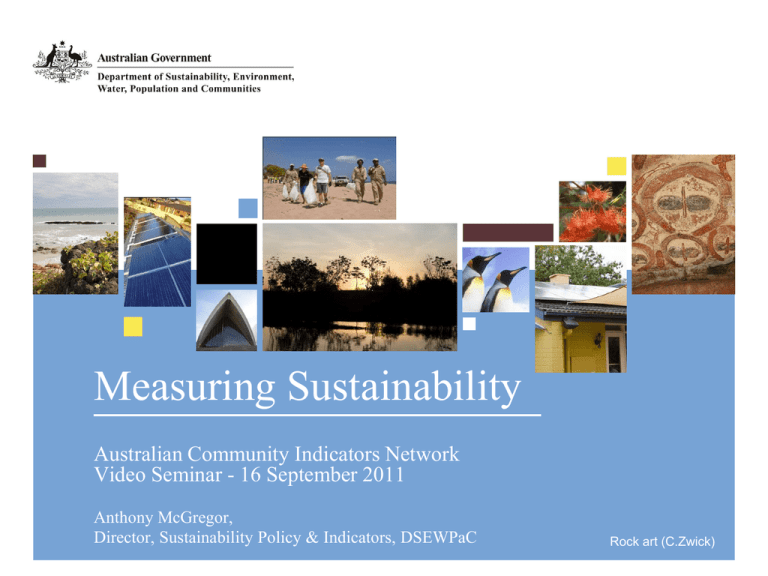Power Point Presentation 3
advertisement

Measuring Sustainability Australian Community Indicators Network Video Seminar - 16 September 2011 Anthony McGregor, Director, Sustainability Policy & Indicators, DSEWPaC Rock art (C.Zwick) Sustainable Australia: Sustainable Communities Strategy to ensure future population change is compatible with the economic, environmental and social wellbeing of Australia Sustainable Population Measures: • Suburban Jobs • Sustainable Regional Development • Measuring sustainability www.environment.gov.au Measuring Sustainability - overview Objective: To deliver information on social, environmental and economic aspects of wellbeing that will support decision making for more sustainable outcomes. Key deliverables: Sustainability Indicators for Australia 10-20 headline indicators addressing economic, social and environmental issues relevant to communities. Products / tools Online Portal – Directory of Sustainability Measurement ‘Sustainable Australia’ Report Sustainability Impact Statements To be introduced as part of Cabinet process Looking to build on, learn from and add value to efforts at the local, national and international scale. www.environment.gov.au Sustainability Indicators for Australia – possible themes Sustainable Australia: Sustainable Communities. A nation of sustainable communities, which have the right mix of services, job and education opportunities, affordable housing, amenity and natural environment, that make them places where people want to live, work and build a future. Maintaining and enhancing the social, economic and environmental capital that underpin community wellbeing for current and future generations. Liveable Communities Environmental Sustainability Economic Prosperity Housing Affordability Traffic Congestion & Transport The Built Environment Ecosystem Health Air Quality Workforce Participation Innovation Capacity Water Consumption and Efficiency Water for the Environment Waste Disposal Food Security Climate Change Economic Efficiency Access to Services Social Inclusion Physical and mental health Culture and identity Security Household Wealth Household Income Education and Training www.environment.gov.au Sustainability indicators for Australia Key considerations: Relevance – can inform decisions and responses by government and communities to enhance overall wellbeing Scalable – can be represented at a scale that is meaningful for policy and management purposes and which makes sense to communities Objective – transparent and does not require interpretation or translation. Trends in the indicator clearly represent an improvement or deterioration in relation to a component of wellbeing (i.e. are outcome focused) Measurable and reliable –quantifiable and statistically robust. Measurement of the indicator is repeatable (and will remain meaningful over time) Data availability – preferable that data be available, indicators for priority issues may be included where data is accessible in the near term. www.environment.gov.au Sustainability Indicators – regions A range of potential approaches to regionalisation. Online portal as a tool for delivering place-based data www.environment.gov.au Where to from here? Consultation – stakeholders, experts, states. Identification of key issues and preferred indicators – later this year. Delivery of indicator products from 2012 www.environment.gov.au Contacts / further information Anthony McGregor Director, Sustainability Policy & Indicators anthony.mcgregor@environment.gov.au 02 6274 2206 www.environment.gov.au


